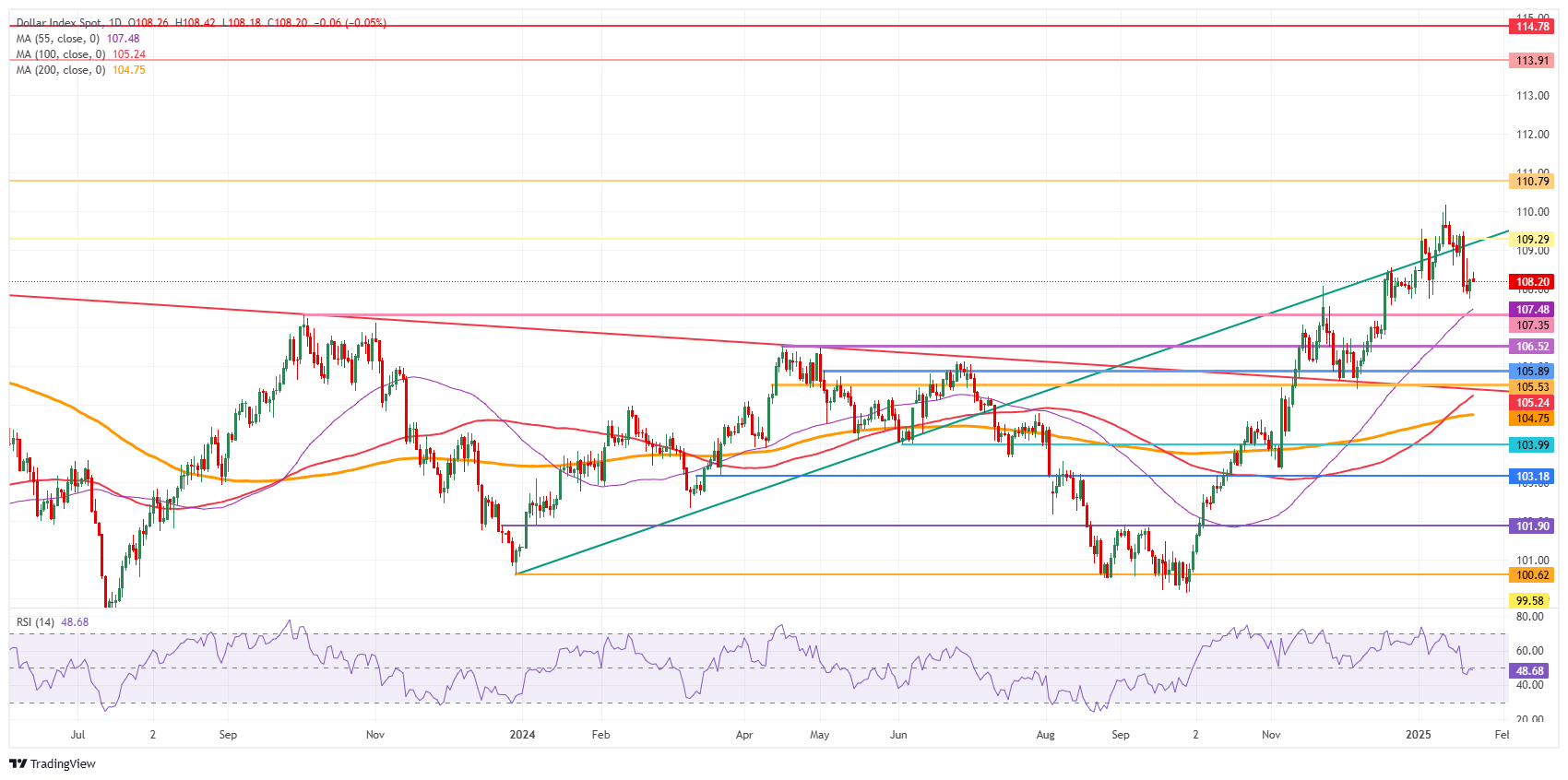US Dollar flat after small recovery staged on Wednesday
- The US Dollar stabilizes further on Thursday with traders bracing for US data.
- US President Trump is set to speak at the World Economic Forum in Davos.
- The US Dollar Index (DXY) is back above 108.00, though faces some mild selling pressure again.
The US Dollar Index (DXY), which tracks the Greenback’s value against six major currencies, is further stabilising and trying to recover further towards levels seen last week before US President Donald Trump’s inauguration. Still, there is a long road to recovery, although after a few days with an almost empty US data calendar, traders can brace for a pickup in the next releases. Positive and upbeat data could put inflation concerns back on the agenda, which would fuel higher rates and a stronger US Dollar again.
Meanwhile, the US economic calendar is starting to take shape with the weekly Jobless Claims and the Kansas Fed Manufacturing Activity Index. This all precedes the release of Friday’s S&P Global Purchase Managers Index (PMIs) numbers. Later this Thursday, US President Trump will also appear virtually at the Davos World Economic Forum where he will hold a speech.
Daily digest market movers: Finally some data
- At 13:30 GMT, the weekly Jobless Claims for the week ending on January 17 are due. Expectations are for the initial claims to tick up to 220,000, coming from 217,000 in last week’s count. The Continuing Claims for the week of January 10 are set to head higher to 1.860 million, from 1.859 million previously.
- At 16:00 GMT, the Kansas Fed will release its manufacturing activity survey for January. No forecast is available, with the previous reading at -5.
- In that same timeframe, US President Donald Trump will make a virtual appearance at the World Economic Forum in Davos.
- Equities are looking sluggish this Thursday, facing some profit-taking after its broad rally throughout the week.
- The CME FedWatch tool projects a 57.1% chance that interest rates will remain unchanged at current levels in the May meeting, suggesting a rate cut in June. Expectations are that the Federal Reserve (Fed) will remain data-dependent with uncertainties that could influence inflation during US President Donald Trump’s term.
- The US 10-year yield is trading around 4.619%, off its poor performance seen earlier this week at 4.528% and still has a long way to go back to the more-than-one-year high from last week at 4.807%.
US Dollar Index Technical Analysis: US data could bring back inflation to the agenda
The US Dollar Index (DXY) halts its correction and consolidates around 108.00 on Thursday. Upcoming US economic data this week could fuel inflation concerns again with higher rates and a stronger US Dollar as a result.
If the recovery in the DXY wants to continue its ascent, the pivotal level to gain control of is 109.29 (July 14, 2022, high and rising trendline). Further up, the next big upside level to hit before advancing further remains at 110.79 (September 7, 2022, high). Once beyond there, it is quite a stretch to 113.91, a double top from October 2022.
On the downside, the first area to watch is 107.80-107.90, which held this week’s correction. Further down, the convergence of the high of October 3, 2023, and the 55-day Simple Moving Average (SMA) around 107.50 should act as a double safety feature to catch any falling knives.

US Dollar Index: Daily Chart
US Dollar FAQs
The US Dollar (USD) is the official currency of the United States of America, and the ‘de facto’ currency of a significant number of other countries where it is found in circulation alongside local notes. It is the most heavily traded currency in the world, accounting for over 88% of all global foreign exchange turnover, or an average of $6.6 trillion in transactions per day, according to data from 2022. Following the second world war, the USD took over from the British Pound as the world’s reserve currency. For most of its history, the US Dollar was backed by Gold, until the Bretton Woods Agreement in 1971 when the Gold Standard went away.
The most important single factor impacting on the value of the US Dollar is monetary policy, which is shaped by the Federal Reserve (Fed). The Fed has two mandates: to achieve price stability (control inflation) and foster full employment. Its primary tool to achieve these two goals is by adjusting interest rates. When prices are rising too quickly and inflation is above the Fed’s 2% target, the Fed will raise rates, which helps the USD value. When inflation falls below 2% or the Unemployment Rate is too high, the Fed may lower interest rates, which weighs on the Greenback.
In extreme situations, the Federal Reserve can also print more Dollars and enact quantitative easing (QE). QE is the process by which the Fed substantially increases the flow of credit in a stuck financial system. It is a non-standard policy measure used when credit has dried up because banks will not lend to each other (out of the fear of counterparty default). It is a last resort when simply lowering interest rates is unlikely to achieve the necessary result. It was the Fed’s weapon of choice to combat the credit crunch that occurred during the Great Financial Crisis in 2008. It involves the Fed printing more Dollars and using them to buy US government bonds predominantly from financial institutions. QE usually leads to a weaker US Dollar.
Quantitative tightening (QT) is the reverse process whereby the Federal Reserve stops buying bonds from financial institutions and does not reinvest the principal from the bonds it holds maturing in new purchases. It is usually positive for the US Dollar.

